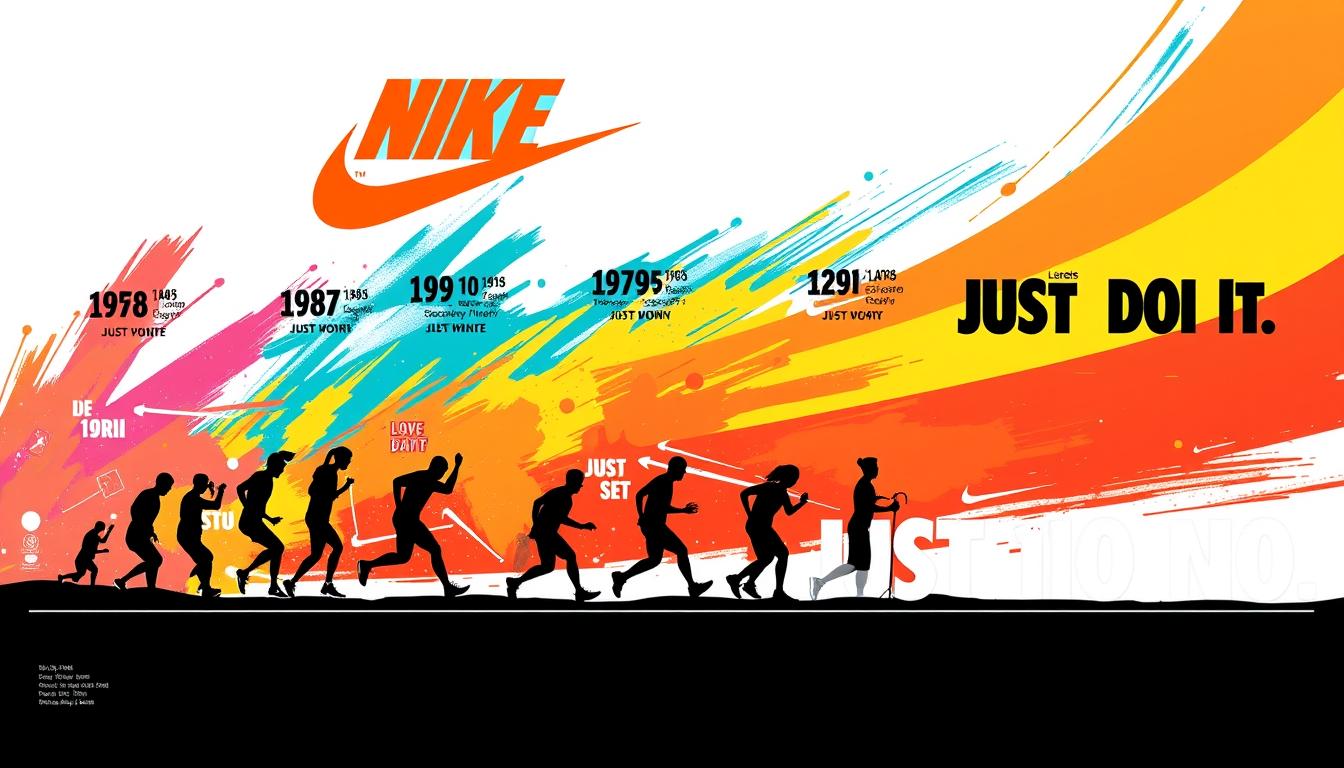
Did you know Nike’s “Just Do It” campaign made sales jump by 31% in its first year? It all started in 1964 as Blue Ribbon Sports, selling shoes from a car trunk. Now, it’s a $51.2 billion giant.
The “Just Do It” slogan, introduced in 1988, did more than just advertise. It became a cultural anthem, mixing sports spirit with daily motivation. Today, Nike is in 170 countries, but its humble start is never forgotten.
Nike’s Just Do It Campaign changed the game with its $35 swoosh logo and over 1,000 athlete partnerships. This Nike campaign didn’t just sell shoes. It made movement a way of life. See how three simple words turned a business into a global icon.
The Origins of the Just Do It Campaign
In 1988, Nike was on the brink of a major change. A marketing strategy from Portland’s Wieden+Kennedy, a rising agency, was key. The famous “Just Do It” slogan came from a surprising place: the last words of Gary Gilmore, a convicted murderer.
Dan Wieden changed Gilmore’s words into a powerful call to action. He said, “The resonance of ‘Just Do It’ was completely inadvertent and unforeseen… people started reading things into much more than sports.”
“The resonance of ‘Just Do It’ was completely inadvertent and unforeseen … people started reading things into much more than sports.” — Dan Wieden
The slogan was first used in a $20 million campaign for cross-training. It aimed at athletes and regular people. By 1998, Nike’s share in North America jumped from 18% to 43%.
This inspirational messaging became a cultural icon. It was boosted by partnerships with stars like Michael Jordan and Colin Kaepernick. Over thirty years, the campaign grew to symbolize strength, as explained in this analysis. It helped Nike’s sales soar from $877 million to $9.2 billion.
The Campaign Launch: A Bold Move in Advertising
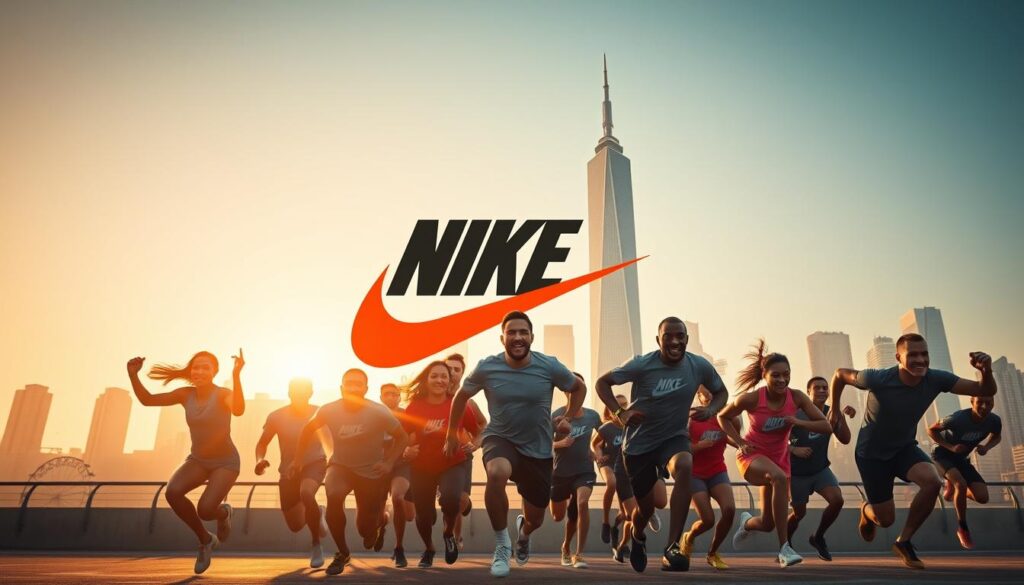
In 1988, Nike launched a $20 million Nike campaign. It used bold storytelling to change how people saw the brand. The ads showed athletes and everyday people pushing past their limits.
This focus on emotional stories, not just product details, was new. It aimed to inspire viewers to embrace the “Just Do It” spirit. This move challenged the usual ways of advertising in sports.
Initial Reactions from the Public
People had mixed feelings about the campaign at first. Some thought it was groundbreaking, while others saw it as too different. Critics said it didn’t clearly show what the product was about.
But fans loved its honest and raw feel. The campaign’s simple black-and-white photos and real moments sparked a lot of talk. It showed how much it could affect people’s thoughts.
Advertising Strategies Used
- Minimalist visuals with black-and-white photography emphasized human effort over flashy graphics.
- Unscripted moments captured real struggles, like a 80-year-old runner, to highlight perseverance.
- Taglines paired with imagery, such as “If you have a body, you are an athlete,” broadened its appeal.
By 1998, Nike’s sales jumped from $877 million to $9.3 billion. This showed the campaign’s lasting brand awareness success. It moved from focusing on details to telling stories, setting Nike up for cultural success. It showed the strength of emotional connections in ads.
Key Milestones in the Just Do It Journey
The Just Do It Campaign has always been about bold and partnerships. These have helped build . Let’s look at the key moments that made it what it is today.
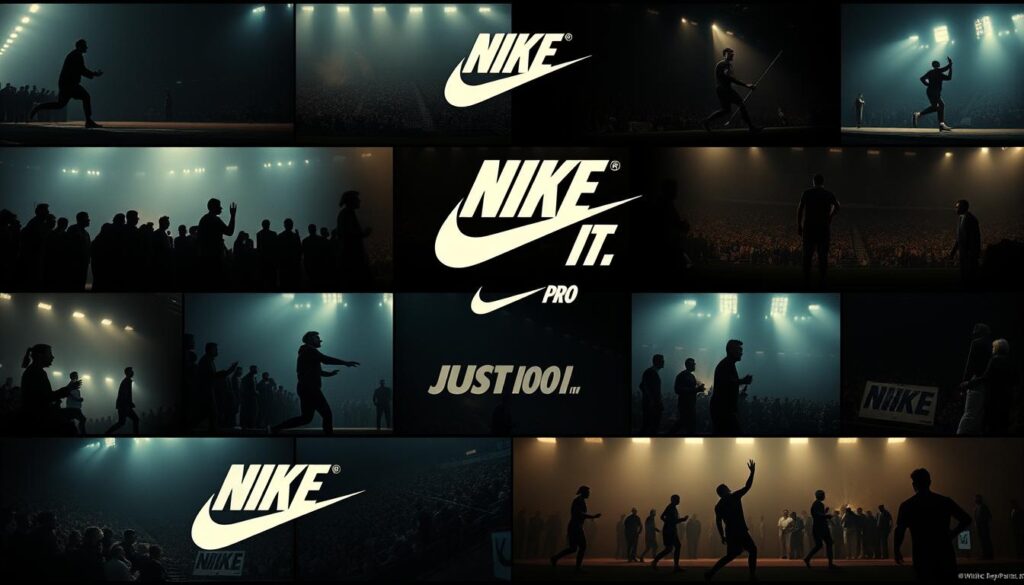
| Year | Event |
|---|---|
| 1988 | Walt Stack’s marathon run ad launched the slogan, proving fitness is for all ages. |
| 1991 | First women’s campaign linked sports to female empowerment, boosting brand relevance. |
| 1995 | Award-winning braille poster for the visually impaired showcased inclusivity. |
| 2018 | Colin Kaepernick’s “Believe in Something” ad sparked debate but boosted Nike’s stock value by $6B. |
Partnerships like Michael Jordan’s 1985 Air Jordan collaboration made sneakers icons. Working with athletes like Serena Williams and LeBron James made Nike’s message real. This led to a huge increase in market share, from 18% to 43% by 1998.
Every campaign, from “Dream Crazier” to Olympic sponsorships, shows Nike’s commitment. It proves that effort is more important than just winning.
These milestones highlight Nike’s . It stays relevant by mixing stories with action. The slogan’s 35-year legacy shows that pushing limits is more than a slogan—it’s a promise.
The Role of Social Media in Campaign Expansion
Nike’s marketing strategy changed with the rise of digital platforms. Now, social media is key for brand awareness. With over 252 million Instagram followers, Nike shares inspiring content. This includes short videos, motivational quotes, and athlete spotlights.
Their accounts like @nikebasketball and @nikewomen focus on specific groups. This approach boosts engagement. An 
- Instagram: 252M followers, 8.8M engagements in 3 months
- YouTube: 21M views for top video, 434.5M total views
- TikTok: 3.1M followers, viral challenges like #JustDoIt
How Nike Leveraged Digital Platforms
Nike’s marketing strategy focuses on each platform’s unique content. Instagram posts highlight athletic achievements. Twitter shares updates from sports events.
YouTube is for long-form athlete documentaries. TikTok is for short, motivational clips. By 2021, these efforts led to $40 billion in revenue. This shows the power of tailored messaging.
Engaging the Audience through User-Generated Content
Nike’s campaigns like #JustDoIt and #BetterForIt encourage users to share their fitness stories. The Nike+ app lets runners log miles and share their progress. This turns customers into brand ambassadors.
“Your story becomes our story,” says Nike’s VP of Digital. This approach makes Nike relatable worldwide, boosting brand loyalty.
Nike combines data analytics with interactive campaigns. This ensures every post connects with the audience. It shows social media is more than just a platform—it’s a conversation.
The Target Audience: Who Does Just Do It Appeal To?
The Nike campaign changed from focusing on athletes to inspiring everyone. Nike made its message broad, reaching out to anyone looking for motivation. Now, its message is for everyone, from weekend runners to office workers, showing that “Just Do It” is about everyday courage.

Expanding Beyond Athletes
Nike started by changing who they saw as athletes. The slogan, “If you have a body, you are an athlete,” became key. They launched campaigns like If You Let Me Play for girls in sports and Courage for athletes with disabilities.
These moves made the Nike campaign a movement, not just a sales pitch.
Focusing on Diverse Demographics
- Age: 15–45 years, with 84.5% of its core audience between 18–44
- Gender: 33% women in the U.S. sports enthusiasts segment, up from earlier male-dominated stats
- Inclusivity: Campaigns feature diverse ethnicities, abilities, and lifestyles, boosting global appeal
“The greatest stories of determination aren’t on the field—they’re in everyday lives.”
Nike’s focus on being relatable helped sales soar from $877 million to $9.2 billion in a decade. By standing for values like equality and resilience, Nike won loyalty across many groups. This approach didn’t just increase brand awareness—it made “Just Do It” a cultural call to action.
The Influence of Cultural Events on the Campaign
Nike’s advertising campaign has thrived by aligning with cultural moments. It uses brand awareness strategies to turn societal conversations into inspiration. From the Olympics to social justice movements, these partnerships fuel inspirational messaging that resonates globally. Let’s explore how these choices shape Nike’s legacy.
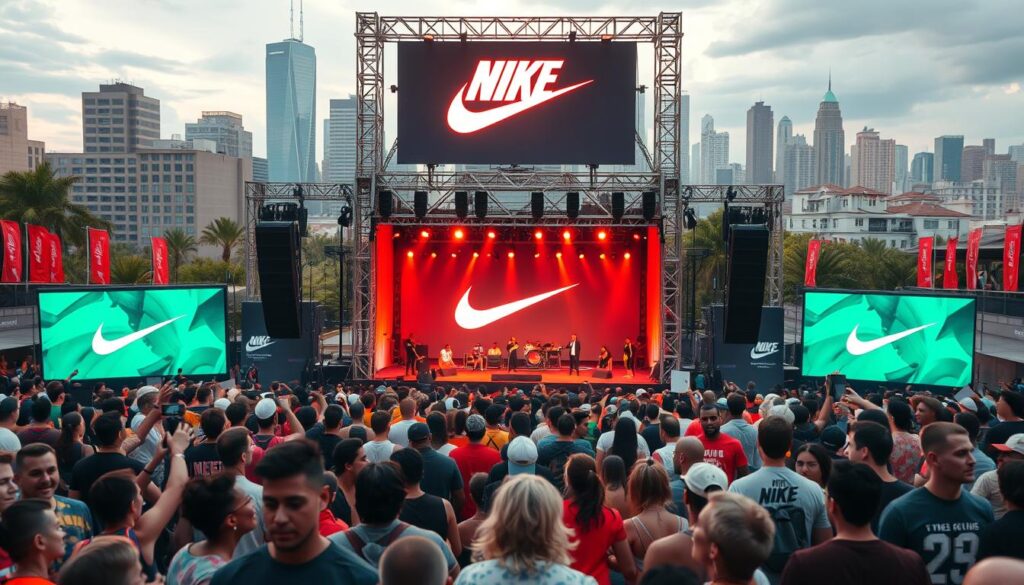
Major Sporting Events and Collaborations
Major events like the Olympics and Super Bowl provided platforms for bold storytelling. During the 2018 World Cup, Nike’s ads highlighted athletes’ perseverance, boosting product sales by 31% after Colin Kaepernick’s involvement. The brand capitalized on these moments to reinforce its message of resilience.
- Super Bowl 2018: Colin Kaepernick’s ad sparked debate but drove millennial investor stock purchases up 18%.
- 2020 Olympics: Campaigns celebrated underdog stories, aligning with the brand awareness goals.
| Campaign | Event | Outcome |
|---|---|---|
| Just Do It 2018 | Super Bowl | 31% sales surge |
| Dream Crazier | Women’s Equality Day | Increased female customer engagement |
Responding to Social Movements
Nike’s stance on issues like racial justice and gender equality redefined risk-taking. The Colin Kaepernick ad initially caused a 3.9% stock dip but later showed resilience. The brand’s 2018 campaign faced backlash but strengthened loyalty among younger demographics.
Data reveals 33% of Americans had negative perceptions post-Kaepernick, yet 72% of millennials viewed the move as authentic. Nike’s strategy balances controversy with purpose, proving that aligning with movements can boost long-term relevance—even amid short-term backlash.
Through these choices, Nike turned cultural shifts into opportunities to evolve its message. Each campaign reflects how the brand adapts its inspirational messaging to stay a leader in both sport and society.
Analyzing the Psychological Appeal of Just Do It
Nike’s “Just Do It” campaign speaks to deep human desires through inspirational messaging. It turns challenges into chances for growth. This fits with self-determination theory, which values autonomy and persistence in building brand loyalty.

- Phrases like “Just Do It” prompt us to act quickly.
- Stories of athletes facing and overcoming obstacles (e.g., “Dream Crazy”) touch our hearts.
- Open-ended messages let us see our goals in the brand.
People started reading things into much more than sports.
Nike’s successful branding uses emotional stories to connect with us. Ads like “Find Your Greatness” celebrate small wins, making fitness a symbol of life’s battles. This approach makes products symbols of resilience, strengthening our bond with the brand.
While controversies like the Kaepernick campaign may cause short-term drops in stock, they build long-term loyalty. By blending psychology with creativity, Nike turns shoes into symbols of self-confidence. This keeps customers coming back for more.
Global Reach: Just Do It Around the World
Nike’s Nike campaign has become a global phenomenon. It balances global consistency with local relevance. With operations in over 170 countries, Nike makes sure its advertising campaign connects everywhere.
The brand’s brand awareness strategy is about adapting messages to fit regional values. Yet, it keeps the “Just Do It” spirit alive.
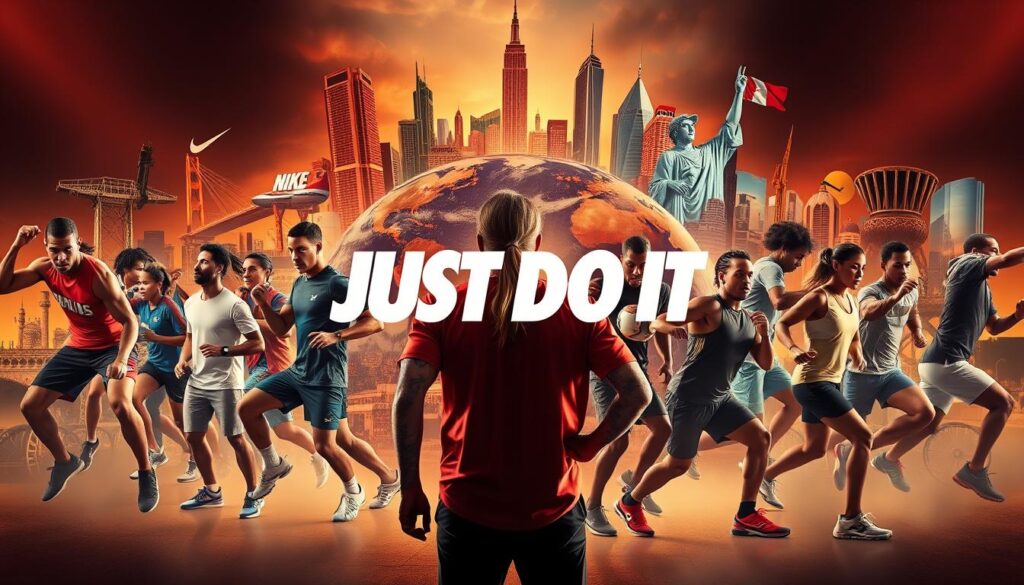
Nike changes its approach for different places. In India, ads feature cricket stars like Rohit Sharma. In China, they use table tennis stars and Lunar New Year themes.
In Europe, soccer is the focus, thanks to partnerships with Cristiano Ronaldo. This glocal strategy shows cultural sensitivity while keeping the brand’s identity.
| Region | Key Adaptations | Local Partners |
|---|---|---|
| Latin America | Soccer-focused campaigns | Partnerships with Copa América and local leagues |
| India | Cricket and fitness trends | Collaborations with Bollywood influencers |
| Asia-Pacific | Traditional festivals in ads | Team-ups with athletes like Neeraj Chopra (India’s javelin star) |
- Localized slogans: “Just Do It” translated while preserving motivational intent
- Product customization: Launching region-specific gear (e.g., Nike Cricket shoes in India)
- Data-driven localization: Using consumer insights to tailor fitness app recommendations
Nike uses analytics to understand what people want. For example, in Africa, ads focus on marathon runners and soccer. By 2023, this approach helped Nike reach $51.54 billion in revenue.
This shows that cultural nuance is key to global success. Nike feels both universal and personal, no matter where you are.
Innovations: Evolving the Campaign for the Future
Nike’s marketing strategy keeps up with new tech and what people value. They use augmented reality and make promises to be more eco-friendly. Their advertising campaigns now mix cool tech with a good cause.
The SNKRS app and virtual try-ons show Nike’s forward thinking. Their goal to be “Move to Zero” by 2025 shows they care about the planet. Here’s how Nike stays on top.
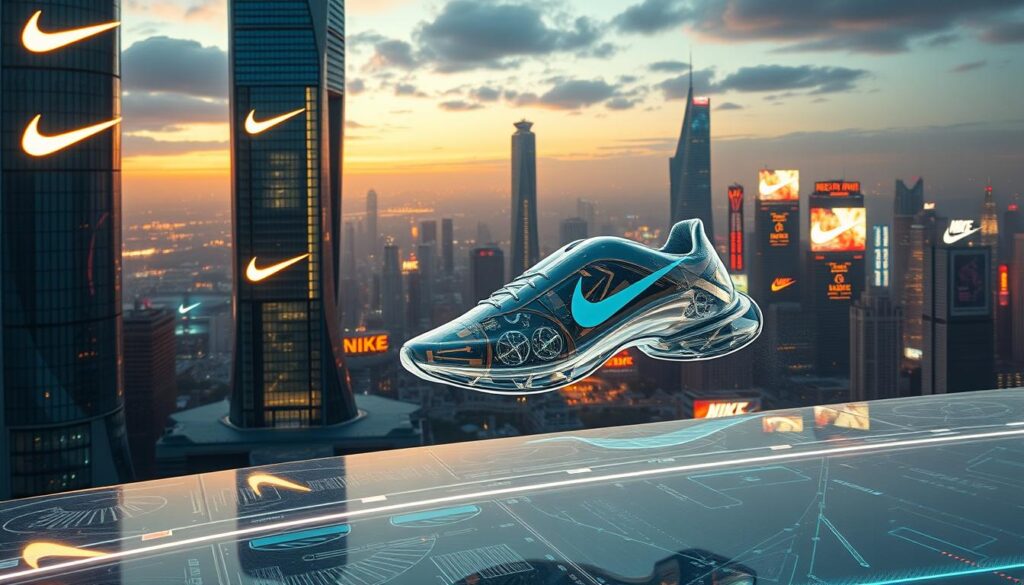
Embracing Technology and Interactive Campaigns
Technology makes people more engaged. Nike’s apps let users design their own shoes or join virtual races. Their digital marketing uses AR to help people try on shoes virtually, cutting down on returns by 30%.
Here are some key tech stats:
| Initiative | Impact |
|---|---|
| SNKRS App | 100M users; 100% growth target by 2023 |
| AR Tech | Virtual try-ons and global running communities |
| AI Insights | Product updates in 48 hours using consumer data |
Sustainability Messaging and Initiatives
Nike wants to be carbon and waste-free by 2025 with “Move to Zero.” Their Space Hippie shoe, made from recycled materials, shows they’re serious about being green. This makes Gen Z fans who care about the planet.
Nike’s focus on tech and ethics keeps their advertising campaign fresh. As markets like China grow (projected 2B digital natives by 2030), these new ideas will help them grow. They stay true to their “Just Do It” spirit.
Measurement of Success: Metrics that Matter
Nike’s successful branding relies on tracking key growth drivers. In 2023, revenue soared to $51.2 billion. But what really matters is the brand’s brand loyalty metrics. Let’s explore how Nike links its campaigns to sales.
- Net Promoter Score (NPS): 78% of Nike customers recommend the brand, showing strong loyalty.
- Customer Lifetime Value (CLV): Loyal customers spend 3x more than first-time buyers.
- Digital Engagement: Campaigns with emotional storytelling boost social shares by 40%.
Data is key to making smart choices. Top teams focus on sales KPIs more than others. But only 36% of brands connect e-commerce SEO strategies to direct sales. Nike bridges this gap by linking ad campaigns to brand loyalty KPIs like retention rates.
The “Dream Crazy” campaign saw a 12% increase in repeat purchases. Metrics like customer churn rate and bounce rate show where to improve. Nike’s bounce rate fell 18% after optimizing for mobile users.
Marketing strategies now focus on building long-term loyalty. By analyzing 83% of marketers’ struggles with attribution, Nike ensures every ad dollar is worth it.
Success in branding comes from combining creativity with data. Nike’s achievements show that successful branding happens when metrics and inspiration come together.
Controversies and Criticisms of the Campaign
In 2018, Nike’s Nike campaign with Colin Kaepernick sparked a big debate. The ad, celebrating their 30th anniversary of “Just Do It,” saw stocks fall 2% and #BoycottNike trend. But, sales jumped 31% in that quarter, showing that controversy can also boost brand awareness.
“Players were encouraged to stand but not required,” stated the NFL in 2016, reflecting tensions that spilled into Nike’s advertising campaign.
- Shares dipped 2% post-launch but rebounded as loyal customers defended the brand.
- Over 1 million #JustBurnIt posts emerged, showing divided public opinion.
- Nike’s stance aligned with younger, progressive demographics despite backlash from conservative groups.
| Metric | Controversy Impact | Support Response |
|---|---|---|
| Stock Drop | 2% initial decline | 31% sales increase |
| Social Media | #BoycottNike | Millennial engagement up 50% |
Nike’s 2018 move showed the risks of linking advertising campaigns to social issues. Critics called the ads “unpatriotic,” but younger people appreciated the bold message. This echoes Pepsi’s 2017 mistake, where a failed campaign backfired completely.
Despite the backlash, Nike’s brand awareness grew. Studies show 70% of millennials view Nike more positively after the Kaepernick ad. Nike faces ongoing challenges in mixing ethical messages with global audiences. Yet, their bold stance has strengthened loyalty among their core fans.
Future Directions for Just Do It
The Just Do It Campaign has made Nike famous for years. Now, the brand must keep its tradition while introducing new ideas. Nike plans to use technology to make ads more personal and focus on helping the community. This could attract more people to the brand.
- AI-driven personalization for motivational content
- Sustainability-focused campaigns linking to environmental goals
- Virtual reality and gaming integrations
Keeping the Just Do It Campaign’s heart while changing is essential. Today’s youth want brands to care about the planet and social issues. The campaign needs to grow but stay true to its roots.
Nike can stay relevant by being quick to adapt. Whether through new tech or standing up for causes, the brand’s next steps will shape the campaign’s future. The mix of data, understanding, and bold stories will show that “Just Do It” is for everyone.
The Role of Celebrity Endorsements in the Campaign
At the heart of the Nike campaign is a strategy that turns athletes into storytellers. Celebrities like Michael Jordan and Serena Williams are more than faces. They are voices that shape brand loyalty.
By partnering with athletes whose stories match the inspirational messaging of “Just Do It,” Nike turns personal victories into global inspirations.
Profiles of Famous Brand Ambassadors
- Michael Jordan: His 1984 partnership launched the Air Jordan line, turning a banned shoe into a cultural icon. Sales of the Air Jordan 1 soared after the NBA’s initial rejection, proving controversy can fuel demand.
- Colin Kaepernick: The “Believe in Something” ad in 2018 sparked debate but boosted Nike’s stock value by $6 billion, showing how bold storytelling resonates.
- Serena Williams: Her decade-long partnership highlights perseverance, aligning with Nike’s focus on pushing limits.
The Impact of Their Personal Stories
When you see a celebrity’s struggle mirrored in ads, it’s not just marketing—it’s motivation. Brand loyalty deepens when athletes like LeBron James share their roots, or Cristiano Ronaldo’s “Dream Crazy” ad ties his immigrant story to resilience. These narratives don’t just sell shoes; they build communities.
Data shows 56% of buyers credit endorsements for their purchasing decisions, proving stories sell.
Nike’s secret? They don’t just hire stars—they co-create legacies. By weaving athletes’ real-life challenges into ads, they turn sneakers into symbols of triumph. This approach fuels inspirational messaging that competitors can’t replicate.
Loyalty Programs and Community Engagement
Nike focuses on building loyalty by creating digital and physical communities. Their apps, like Nike Run Club and Training Club, help users track workouts and connect with friends. This mix of fitness andsuccessful branding makes users feel special.
Members get exclusive deals, free shipping, and special events. These perks help spread the word about Nike, boostingbrand awareness.
“If you have a body, you are an athlete.”
This mission inspires local running meetups and the SNKRS app. The SNKRS app saw revenue jump from $70M to $700M in just five years. Here’s how Nike builds connections:
- NikePlus: 100M+ members get personalized training plans and early access to products.
- SNKRS App: 400K monthly users help drive 20% of digital sales through limited releases.
- User-Generated Content: Hashtags like #NikeRunning encourage users to share, growing Nike’s reach.
| Program | Users | Impact |
|---|---|---|
| NikePlus | 100M+ | 3x higher spending vs non-members |
| SNKRS | 400K/month | 20% of digital revenue |
| Nike Run Club | Global | 170+ countries with local events |
79% of users value exclusive perks, and 47% prefer brands with active communities. Nike’s approach to fitness and social interaction has led to $51B in annual revenue. These efforts create a community where customers become brand ambassadors. This shows thatsuccessful branding thrives when people feel included in the brand’s story.
Conclusion: The Lasting Impact of Just Do It
For over three decades, the Just Do It Campaign has set the standard for successful branding. Launched in 1988 by Wieden+Kennedy, it turned Nike into a $34.8 billion giant. This success comes from mixing inspirational messaging with the ability to change and grow.
Reflections on Its Evolution
The campaign has grown from Michael Jordan’s Air Jordan ads to Colin Kaepernick’s 2018 anthem protest. Despite some backlash, Nike’s message of empowerment boosted sales by 1,000% from 1988-1998. Today, 97% of people know the brand, showing that emotional stories last longer than trends.
Your Takeaway: Lessons for Your Branding
Nike’s success isn’t just about slogans. It’s about telling real stories, like Serena Williams or the Kaepernick ad. This approach builds loyalty. To succeed, focus on emotional connections, take smart risks, and let your values lead your campaigns. Whether you’re new or established, Just Do It shows that staying true and bold can make a big difference.

 The Evolution of Nike’s Just Do It Campaign: From Humble Beginnings to Global Domination
The Evolution of Nike’s Just Do It Campaign: From Humble Beginnings to Global Domination
0 Comment